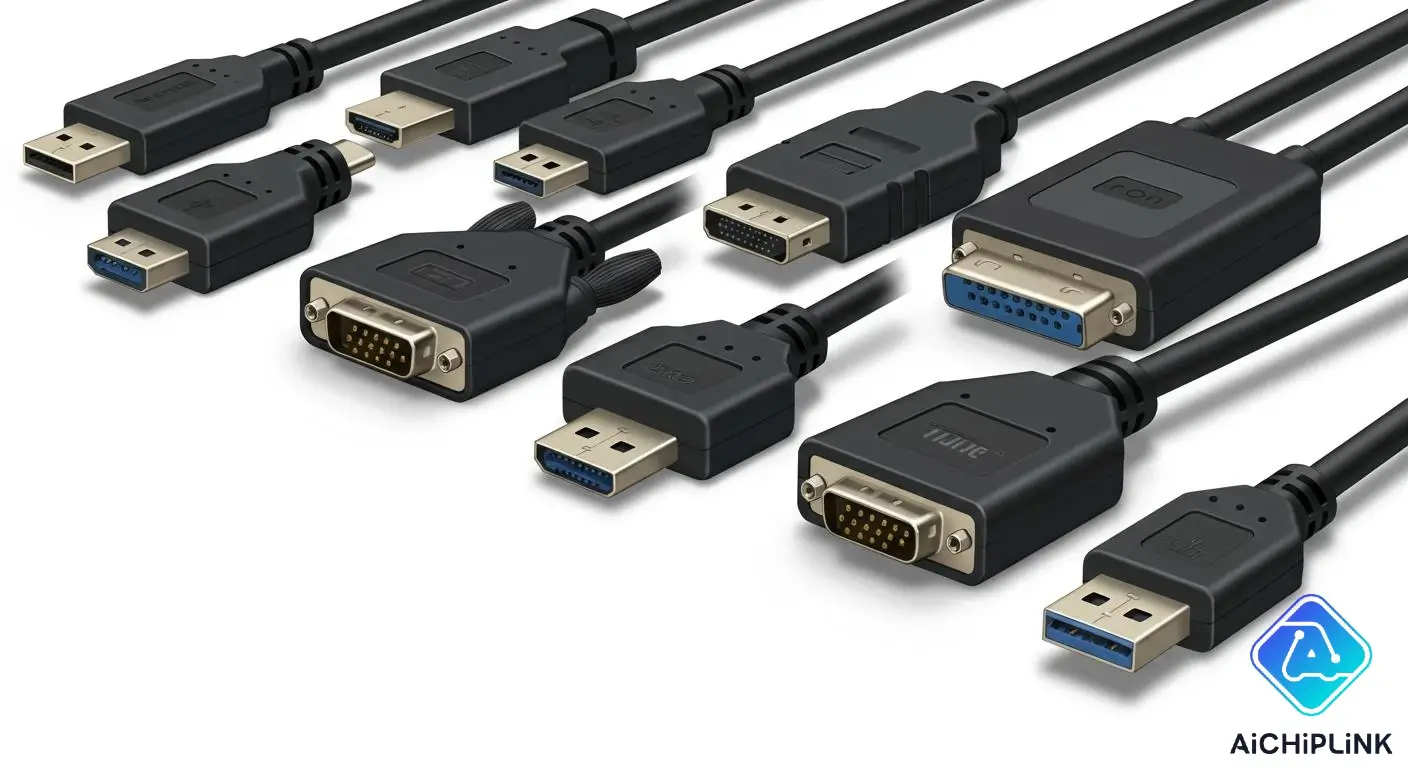
When you set up a monitor, you usually pick from different types of monitor cables. The most common types are:
-
HDMI
-
DisplayPort
-
VGA
-
DVI
-
USB-C
You can find VGA cables in many schools and offices with old computers. DVI cables are good when you do not need high resolution. USB-C cables are popular now because they send video and power for new devices. These types of monitor cables have changed as time passed, making it easier to connect your screen. If you know the differences between these types of monitor cables, you can choose the best one for your setup.
Key Takeaways
-
HDMI cables are used most for monitors and TVs. They send both high-quality video and sound in one cable.
-
DisplayPort is best for gaming and fast computers. It gives higher refresh rates and can link many monitors together.
-
DVI cables give a clear digital picture but no sound. You will see them mostly with older monitors.
-
VGA cables are old and use analog signals. This can make the picture look worse. Only use VGA if you have no other choice.
-
USB-C and Thunderbolt cables are the newest types. They send video, sound, data, and power at the same time. This makes them very useful.
Types of Monitor Cables
When you check out the types of monitor cables, you can see how technology has changed a lot. Every cable type has its own good and bad points. Some cables use digital signals, but others use analog signals. Digital cables like hdmi and displayport show sharper pictures and brighter colors. Analog cables, like VGA, can lose picture quality and show more static. Let’s look at the main monitor cable types you might see today.
HDMI
HDMI means High-Definition Multimedia Interface. You use this cable for most TVs, monitors, and game consoles. It sends video and sound through one cable, so it is very popular. Over the years, hdmi has gotten much better. At first, it only worked with 1080p, but now it works with 4K and even 8K screens.
Tip: If you want to hook up a new monitor or TV, hdmi is usually the best pick.
Here is a table that shows how hdmi standards have changed and what they can do:
| HDMI Standard | Bandwidth (up to) | AV Capabilities |
|---|---|---|
| Standard HDMI | 4.95Gbps | 1080p |
| High Speed HDMI | 10.2Gbps | 4K24, HDR, wide color gamuts |
| Premium High Speed HDMI | 18Gbps | 4K60, HDR, 4:4:4 chroma sampling |
| Ultra High Speed HDMI | 48Gbps | Uncompressed 8K video - 8K60, 4K120 |
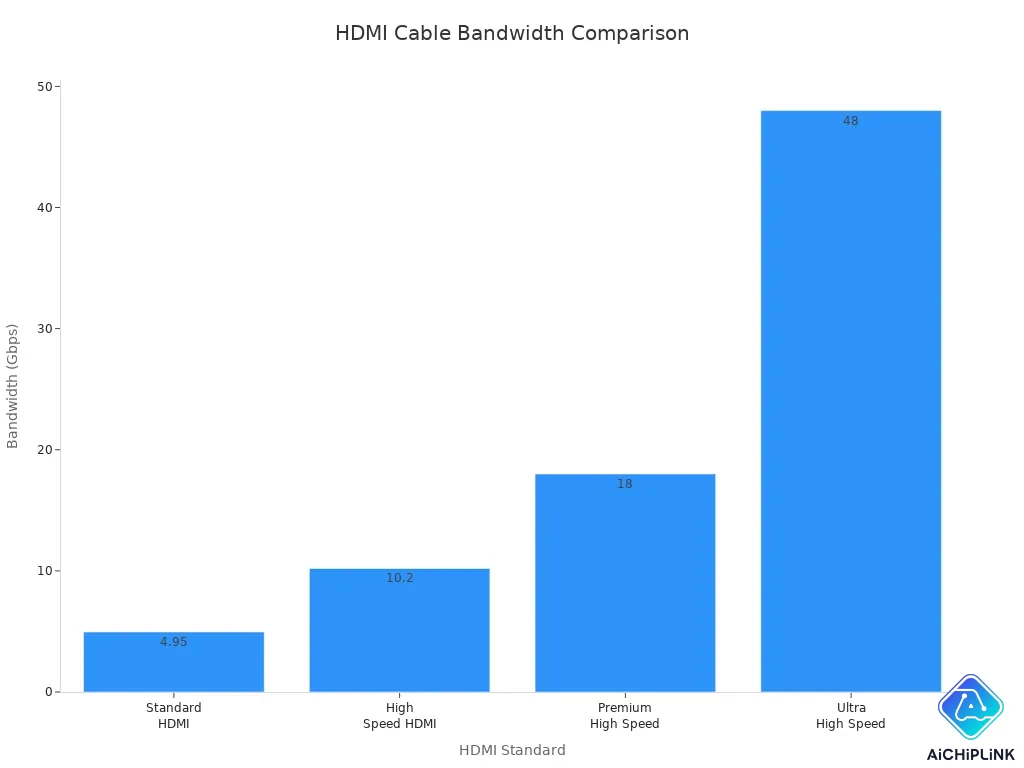
Newer hdmi cables can send a lot more data. This lets you get higher screen quality and smoother video. Hdmi also has features like HDR, which makes colors look more real.
The table below shows how hdmi versions have changed over time:
| HDMI Version | Release Year | Key Features |
|---|---|---|
| HDMI 1.0 | 2002 | 4.95Gbps, 1080p, 8 audio channels |
| HDMI 1.1 | 2004 | Added DVD audio and SACD audio formats |
| HDMI 1.2 | 2005 | Enhanced audio support |
| HDMI 1.3 | 2006 | Improved resolution, color, lip sync, surround |
| HDMI 1.4 | 2009-2011 | Support for 4K, 3D, Ethernet, audio return |
| HDMI 2.0 | 2013 | 18Gbps, 3840x2160@60Hz, 32 audio channels |
| HDMI 2.1 | 2017 | 48Gbps, 8K@60p, dynamic HDR, eARC support |
Hdmi is now the main cable for most new devices. You can use it for computers, monitors, TVs, and projectors. Out of all monitor cable types, hdmi is the most used at home.
DisplayPort
Displayport is another digital cable you see with computers and fancy monitors. It looks a bit like hdmi, but it has some special things. Displayport can handle higher refresh rates and better screen quality, which is great for games and work.
Here is a table that compares displayport and hdmi:
| Feature | DisplayPort 1.4 | HDMI 2.0 | HDMI 2.1 | DisplayPort 2.1 |
|---|---|---|---|---|
| Maximum Bandwidth | 32.4 Gbps | 18 Gbps | 48 Gbps | 80 Gbps |
| 4K Resolution | Up to 120Hz | Up to 60Hz | Up to 120Hz | Up to 240Hz |
| 8K Resolution | Up to 30Hz | Not supported | Up to 30Hz | Up to 60Hz |
| Unique Features | Supports DSC | ARC/eARC | eARC | Improved USB-C |
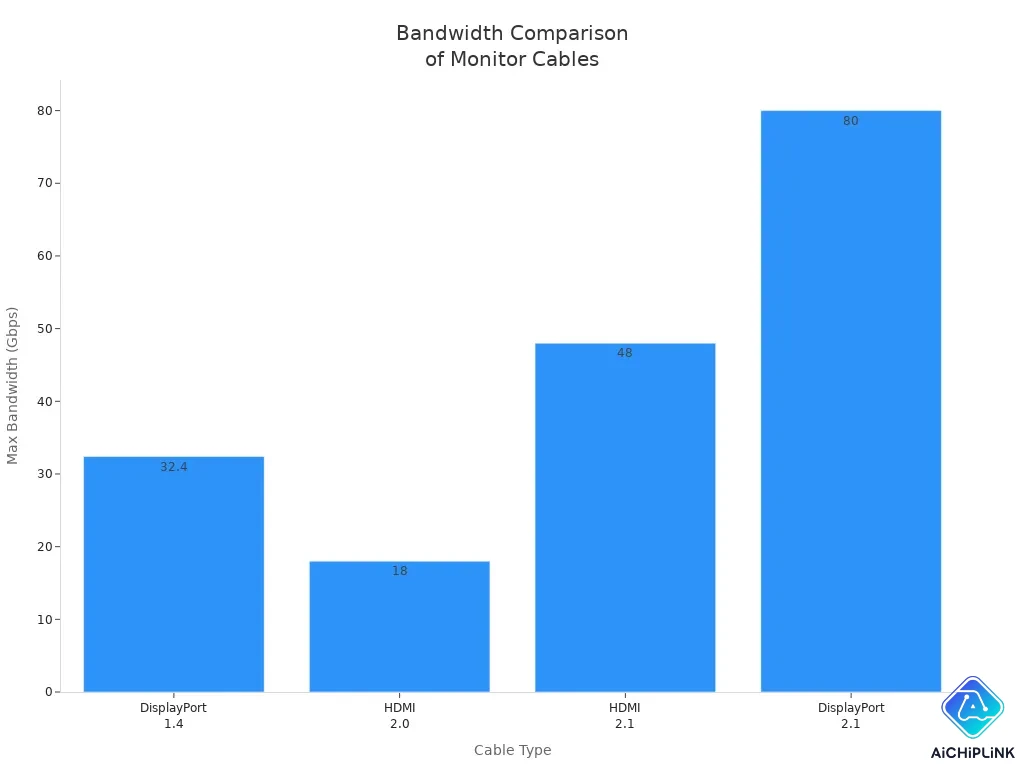
Displayport lets you use more than one monitor with just one cable. This is called Multi-Stream Transport. You also get higher refresh rates, so games and videos look smoother. Displayport 1.4 can send 4K video at 144Hz, which is much better than old monitor cable types.
Note: Displayport is best if you want high refresh rates or more than one monitor.
DVI
DVI stands for Digital Visual Interface. You find this cable on older monitors and some graphics cards. There are two main types: DVI-D (digital only) and DVI-I (digital and analog). DVI can send a digital signal, but it does not send sound like hdmi or displayport.
Here is a table that compares DVI to other monitor cable types:
| Feature | DVI-D | DVI-I | HDMI/DisplayPort |
|---|---|---|---|
| Max Resolution (Single Link) | 1920x1200 | 1920x1200 | Higher than DVI |
| Max Resolution (Dual Link) | 2560x1600 | 2560x1600 | Up to 8K |
| Analog Signal Support | No | Yes | No |
| Compatibility | Limited to digital devices | Compatible with analog/digital | Widely compatible |
| Use Case | High-res digital displays | Versatile for many monitors | Best for modern setups |
DVI was better than VGA because it could send a digital signal. But it is not as fast or full of features as hdmi and displayport. You might still use DVI if you have an old monitor, but most new devices use other monitor cable types.
VGA
VGA is one of the oldest monitor cable types. It uses an analog signal, so the picture can get worse if the cable is long or there is interference. You might see VGA in schools or offices with old computers.
Here is a table that shows how VGA compares to digital cables:
| Cable Type | Signal Type | Impact on Quality |
|---|---|---|
| VGA | Analog | Signal loss, noise, washed out colors, less sharp |
| HDMI | Digital | High quality, less interference |
| DisplayPort | Digital | High quality, less interference |
-
VGA uses analog signals, so colors can look faded.
-
The picture is not as clear as with digital cables.
-
Digital cables like hdmi and displayport give you a much better picture.
Alert: For the best picture, do not use VGA unless you have no other choice.
USB-C/Thunderbolt
USB-C and Thunderbolt are the newest monitor cable types. You see these cables on many new laptops, tablets, and monitors. USB-C can send video, data, and power all with one cable. Thunderbolt is even faster and lets you connect more than one device together.
Here is a table that compares USB-C/Thunderbolt to other monitor cable types:
| Feature | USB-C/Thunderbolt | HDMI/DisplayPort |
|---|---|---|
| Resolution Support | Up to 8K at 60Hz with compression | Up to 4K at 60Hz (HDMI 2.0) |
| Data Transmission | 10Gbps (USB 3.2) | HDMI 2.0: 18Gbps, DP 1.4: 32.4Gbps |
| Power Delivery | Up to 100W | None |
| Cable Compatibility | One cable for video, data, and power | Separate cables for video and power |
| Daisy-Chaining | Yes (Thunderbolt) | Limited (DisplayPort) |
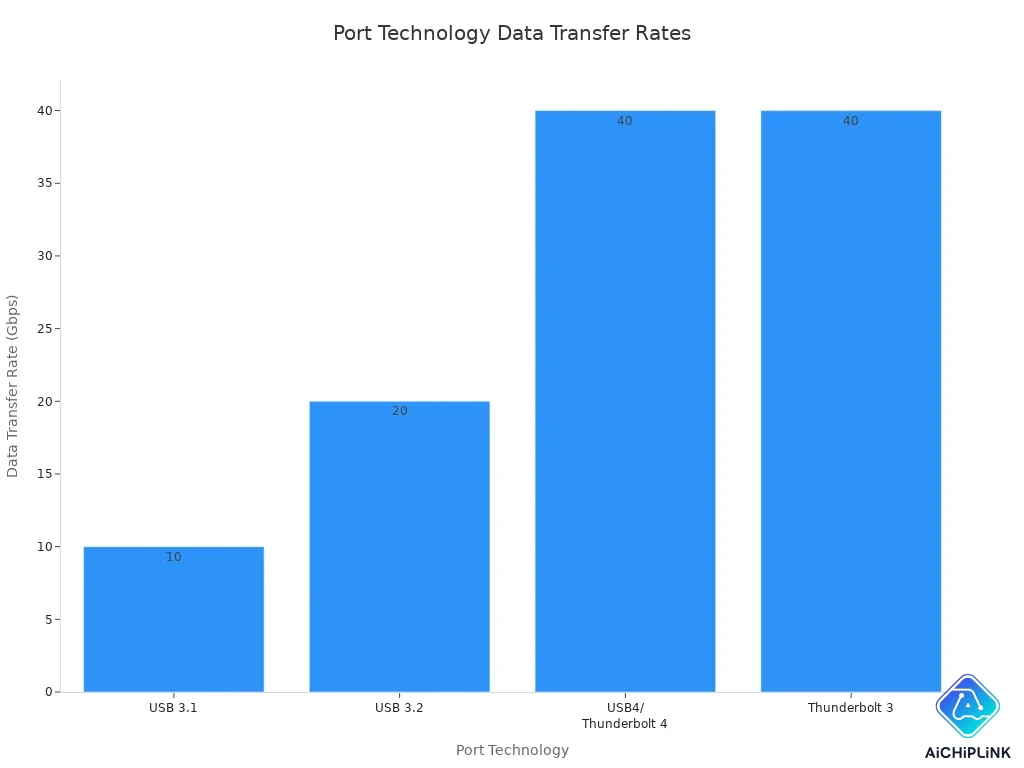
Many new laptops only have USB-C ports. You can use one cable to charge your laptop and send video to your monitor. Thunderbolt lets you connect more than one monitor or device in a row. These new monitor cable types make your desk look neat and simple.
Tip: If your device has USB-C or Thunderbolt, you get fast speeds, high screen quality, and easy setup.
When you pick a monitor cable type, think about your device, the ports you have, and the quality you want. Digital cables like hdmi and displayport give you the best picture and sound. DVI and VGA are older and may not work with new features. USB-C and Thunderbolt are the newest monitor cable types, giving you more choices and better performance.
HDMI and DisplayPort
Features
Modern monitors often use two main cables. These are hdmi and displayport. Both cables send digital signals. This means you get clear pictures and sound. Hdmi is very common in homes. You see it on TVs, gaming consoles, and laptops. Displayport is used more in offices and gaming computers. It gives extra features for high-performance screens.
Here is a table that shows how hdmi and displayport compare:
| Feature | HDMI 2.0 | DisplayPort 1.4 |
|---|---|---|
| Maximum Bandwidth | 18 Gbps | 32.4 Gbps |
| 4K Resolution | Up to 60Hz | Up to 120Hz |
| 8K Resolution | Not supported | Up to 30Hz |
| Variable Refresh Rate | Limited support | Supports FreeSync and G-Sync |
| Cable Length | Max 3 meters | Max 5 meters |
| Multi-Monitor Support | No | Yes (MST) |
| Dynamic HDR Support | Yes | No |
Hdmi 2.1 and displayport 2.1 are even better. Hdmi 2.1 can send up to 48 Gbps and 8K at 60Hz. Displayport 2.1 can reach 80 Gbps and 10K at 60Hz.
Uses
You use an hdmi cable for most home devices. It works with TVs, soundbars, and game consoles. Hdmi is easy to find and fits almost every device at home. Displayport is different. You see it in offices, gaming computers, and places with more than one monitor.
Here is a chart that shows which devices use hdmi or displayport more often:
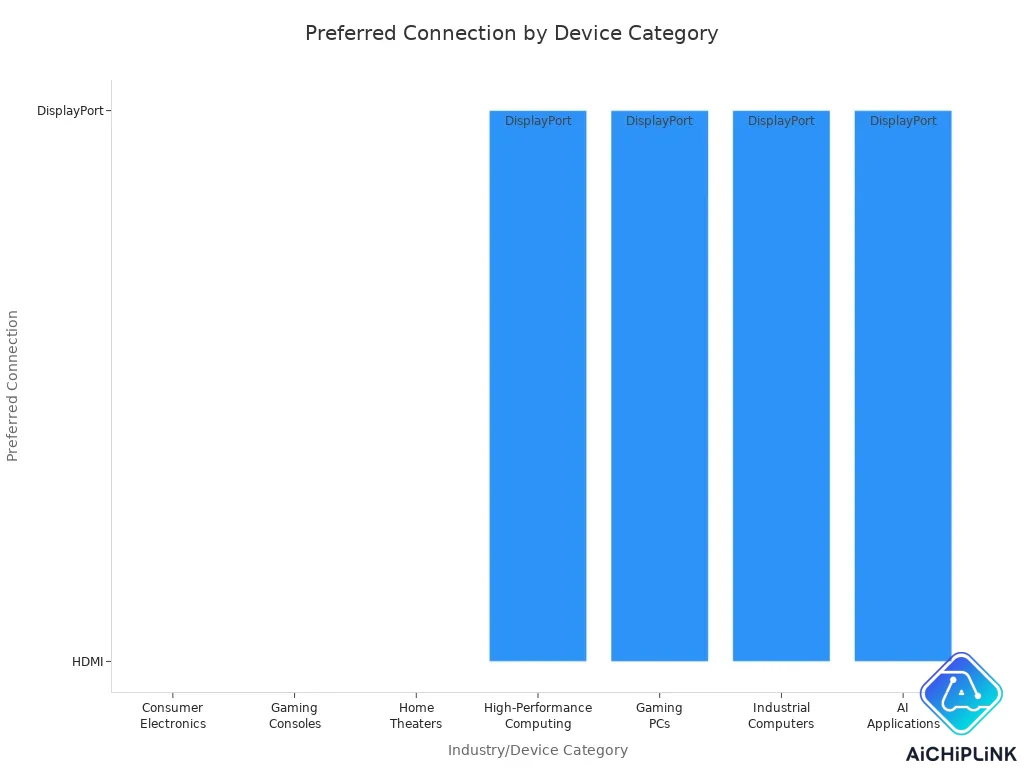
-
Hdmi is best for home entertainment, TVs, and console gaming.
-
Displayport is better for gaming PCs, multi-monitor setups, and high-performance workstations.
Pros and Cons
Both hdmi and displayport have good and bad sides. You should know these before you pick a cable.
| Pros of HDMI | Cons of HDMI |
|---|---|
| Works with most devices | Lower bandwidth than displayport |
| Sends audio and video | Limited multi-monitor support |
| Supports HDR | Shorter cable length for best signal |
| Pros of DisplayPort | Cons of DisplayPort |
|---|---|
| Higher bandwidth | Not as common in home devices |
| Supports more monitors | Some cables are short for best quality |
| Great for gaming and work | Fewer TVs support displayport |
Tip: If you want to connect a gaming PC to a high-refresh monitor, use a displayport cable. For a TV or console, an hdmi cable is usually the best choice.
DVI, VGA, and USB-C
Features
Dvi, vga, and usb-c cables all have their own features. Dvi and vga are older cables. Usb-c is much newer. Dvi uses digital signals. This means the picture looks clear. Vga uses analog signals. The image can look blurry or faded. Usb-c is special. It can send video, audio, data, and power with one cable.
Here is a table that shows their technical features:
| Cable Type | Supported Resolutions | Bandwidth |
|---|---|---|
| vga | Up to 1080p Full HD | N/A |
| DVI-A | 1920x1200 at 60 Hz | N/A |
| DVI-I (Single Link) | 1920x1200 at 60 Hz | N/A |
| DVI-I (Dual Link) | 2560x1600 at 60 Hz | N/A |
| DVI-D (Single Link) | 1920x1200 at 60 Hz | N/A |
| DVI-D (Dual Link) | 2560x1600 at 60 Hz | N/A |
| usb-c | Up to 4K UHD | N/A |
Usb-c can show higher resolutions than vga or dvi. Dvi can reach 2560x1600 if you use dual-link. Vga supports up to 1080p. The picture can get worse if the vga cable is long.
Uses
You use these cables in different places. Vga is common in old offices and schools. Dvi works for old monitors and some gaming. Usb-c is popular for new laptops, tablets, and some phones. You can connect many devices with just one usb-c port.
Here is a table with typical uses:
| Cable Type | Typical Use Cases |
|---|---|
| vga | Office work, conference rooms, connecting older monitors |
| dvi | Casual gaming, connecting older monitors |
| usb-c | High-end gaming, connecting multiple devices to a single port |
Note: Usb-c can connect your laptop to a monitor. It can also charge your device and move files at the same time.
Pros and Cons
It is good to know the pros and cons before you pick a cable.
| Cable Type | Advantages | Disadvantages |
|---|---|---|
| vga | Good compatibility, adapts to different resolutions | Large signal loss, blurred image quality, supports up to 1080p, needs digital-to-analog conversion |
| dvi | Clear picture quality, supports high refresh rate, no signal loss | Does not support audio, needs extra audio cable |
| usb-c | Sends video, audio, data, and power; supports high resolutions; future-proof | Not all usb-c ports support video output; may need adapters |
Device compatibility is important when you choose a cable. Vga works with many old devices. You might need an adapter for new computers. Dvi is not used as much now. You may still see it on some monitors. Usb-c is a good choice for the future. Always check if your usb-c port can send video.
Tip: Usb-c is best if you want a cable for new tech and high-quality screens.
Choosing the Right Cable
Compatibility
When you choose a monitor cable, you need to check if it matches your devices. Look at the ports on your monitor and computer. Some devices have only usb ports, while others have HDMI, DisplayPort, or VGA. You should also check if you need a male or female connector. Most monitors and computers use male-to-male cables, but some setups need a different type.
Here is a table to help you see which cable works with your device:
| Cable Type | Compatibility | Notes |
|---|---|---|
| HDMI | High resolution, supports audio | Common for TVs and monitors |
| DisplayPort | High refresh rates, supports audio | Great for gaming monitors |
| VGA | Lower resolution, no audio | Older technology |
| usb | Video, audio, data, power | New laptops and tablets |
Tip: Always make sure your cable matches the ports on both your monitor and your computer. If you have only usb ports, pick a usb cable for the best results.
Resolution and Refresh Rate
The cable you pick affects how sharp and smooth your screen looks. Some cables support higher resolutions and refresh rates. If you want a clear picture, choose a cable that can handle your monitor’s needs. For example, usb cables can send video up to 8K, while VGA cables work only for lower resolutions.
Here is a table that shows what each cable can do:
| Cable Type | Maximum Resolution | Maximum Refresh Rate |
|---|---|---|
| VGA | Limited | Limited |
| DVI | 1080p | Limited |
| HDMI 2.1 | Up to 16K | Up to 240Hz |
| DisplayPort | Up to 4K | Up to 120Hz |
| usb | Up to 8K | Up to 60Hz |
If you use a usb cable, you can get high-quality video and fast refresh rates. This is important for gaming or watching movies. Always check your monitor’s specs and pick a cable that matches.
Note: Not all usb ports support video. Look for a small display icon next to the usb port to make sure it can send video.
Device Ports
Your choice of cable depends on the ports you have. Some computers and monitors have only usb ports. Others have HDMI, DisplayPort, or VGA. The type of port decides what kind of cable you need. Usb cables are popular because they can send video, audio, data, and power all at once.
-
Check your monitor and computer for available ports.
-
Use adapters if your devices have different ports.
-
Usb cables work well for new laptops, tablets, and monitors.
-
HDMI and DisplayPort are good for high-quality video and sound.
-
VGA is best for older devices.
Alert: If your device has only usb ports, you must use a usb cable or a usb adapter to connect your monitor.
Choosing the right cable helps you get the best picture and sound. Usb cables are a smart choice for new devices. Always match your cable to your device’s ports, and check the resolution and refresh rate you need.
You can pick from many monitor cable types. Each type is good for something different. Here is a simple chart:
| Cable Type | Description | Key Features |
|---|---|---|
| HDMI | Used with TVs and monitors | Shows clear video and sound |
| DisplayPort | On desktop monitors | Fast, works with more than one monitor |
| DVI | For older monitors | Video only, can be digital or analog |
| VGA | For very old monitors | Analog, not very clear, lower resolution |
| USB-C | On new laptops and tablets | Sends video, sound, data, and power |
| Thunderbolt | On fancy devices | Very fast, can link many devices together |
When you choose a cable, remember these things:
The cable changes how good your picture looks and how smooth it is.
Your monitor and computer must have the same kind of port as the cable.
Picking the right cable gives you the best screen for games, work, or watching movies.

Written by Jack Elliott from AIChipLink.
AIChipLink, one of the fastest-growing global independent electronic components distributors in the world, offers millions of products from thousands of manufacturers, and many of our in-stock parts is available to ship same day.
We mainly source and distribute integrated circuit (IC) products of brands such as Broadcom, Microchip, Texas Instruments, Infineon, NXP, Analog Devices, Qualcomm, Intel, etc., which are widely used in communication & network, telecom, industrial control, new energy and automotive electronics.
Empowered by AI, Linked to the Future. Get started on AIChipLink.com and submit your RFQ online today!




